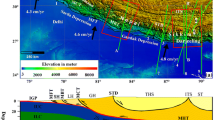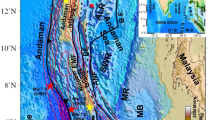Abstract
The Ryukyu trench-arc system can be divided into two types according to its subduction model. The normal subduction in the northern part of the Philippine Sea plate creates a hinge sedimentary wedge with large deformation at the collision front, while the oblique subduction in the southern part gives rise to a smaller accretion with small deformation than that in the northern part. The mechanisms that cause distinction between these two types have been analysed and calculated by using gravity data based on the lithosphere rheology and the stress state of the lithosphere in the subduction boundary. The two types of subduction model are associated with the internal extension in the southern Okinawa Trough and the small extension in the northern part. The difference of the stress state between the two types of subduction model is also manifested in other tectonic features, such as topography, volcanic activity and crust movement. Modeling bathymetric and gravity data from this area suggests that the oblique subduction of low angle, together with smooth geometry of the overlying plate crust, results in small stress released on the south of the trench by the subduction plate. The intraplate faults in the southern Okinawa Trough behind the trench stand in surplus intensive stress. On the other hand, the normal subduction of high angle, together with strong undulation geometry of the overlying crust, results in more intensive stress released in the northern Ryukyu Trench than that in the south. The intraplate faults in the northern Okinawa Trough behind the northern Ryukyu Trench stand in small stress.
Similar content being viewed by others
References
Brian Taylor, 1995. Backarc Basins, Tectonics and Magmatism. Plenum Press, New York, pp. 64–67.
Christeson, G. L., and M. K. McNutt, 1992. Geophysical constraints on the shear stress along the Marquesas fracture zone. J. Geophys. Res., 97: 4425–4437.
Iwasaki, T., 1990. Crustal and upper mantle structure in the Ryukyus Island Arc deduced from deep seismic sounding. Geophys. J. Int., 102: 631–650.
Kamata, H., 1994. Tectonics of an arc-arc junction: an example from Kyushu Island at the junction of the southwest Japan Arc and the Ryukyu Arc. Tectonophysics, 233: 69–811.
Kodaira, S., 1996. Crustal structure across the middle Ryukyu Trench obtained from ocean bottom seismographic data. Tectoniphysics, 263: 39–60.
Letouzey, J., 1986. The Okinawa Trough: genesis of a back-arc basin developing along a continental margin. Teconophysics, 125: 209–230.
Molnar, P., 1978. Interarc spreading and cordilleran tectonics as alternates related to the age of subducted oceanic lithosphere. Earth. Planet. Sci. Lett., 41: 330–340.
Park, J. O., 1998. Seismic record of tectonic evolution and backarc rifting in the southern Ryukyu island arc system. Tectonophysics, 294: 21–42.
Parker, R. L., 1972. The rapid calculation of potential anomalies. Geophys. J. R. Astron. Soc., 31: 447–455.
Phillippe, E., 1997. Active deformation of Asia: from Kinematics to dynamics. Science, 278(24): 647–650.
Sandwell, D. T., E. L. Winterer, J. Mammericx, R. A. Duncan, M. A. Lynch, et al., 1995. Evidence for diffuse extension of the Pacific Plate from Pukapuka Ridges and cross-grain gravity lineations. J. Geophys. Res., 100: 15087–15099.
Scholz, C. H., 1995. On the mechanism of seismic decoupling and back arc spreading at subduction zones. J. Geophys. Res., 100: 22103–22115.
Seno, T., 1993. A model for the motion of the Philippine Sea plate consistent with NUVEL-1 and geological data. J. Geophs. Res., 98(B10): 17941–17948.
Sheffels, B., and M. K. McNutt, 1986. Role of subsurcase loads and regional compensation in the isostatic balance of the Transverse Ranges, California: Evidence for intercontinerntal subsection. J. Geophys. Res., 91: 6419–6431.
Shiono, K., 1980. Tectonics of the Kyusyu-Ryukyu Arc as evidenced from seimicity and focal mechanics of shallow to intermediate-depth earthquakes. J. Phys. Earth, 28: 17–43.
Sibuet, J. C., 1987. Back arc extension in the Okinawa Trough. J. Geophys. Res., 92(B13): 14041–14063.
Veichow, C. J., 1986. Thermal-tectonic evolution of the yellow sea and east China sea-implication for transformation of continental to oceanic crust and marginal basin formation. Tectonophysics, 125: 231–244.
Viallon, C., 1986. Opening of the Okinwaw basin and collision in Taiwan: a retreating trench model with lateral anchoring. Earth and Planetary Science Letters, 80: 145–155.
Author information
Authors and Affiliations
Corresponding author
Rights and permissions
About this article
Cite this article
Lihong, Z., Xiaodian, J. & Weigang, Z. A new model of lithosphere deformation beneath the Okinawa Trough based on gravity data. J Ocean Univ. China 1, 165–170 (2002). https://doi.org/10.1007/s11802-002-0013-9
Received:
Accepted:
Issue Date:
DOI: https://doi.org/10.1007/s11802-002-0013-9




